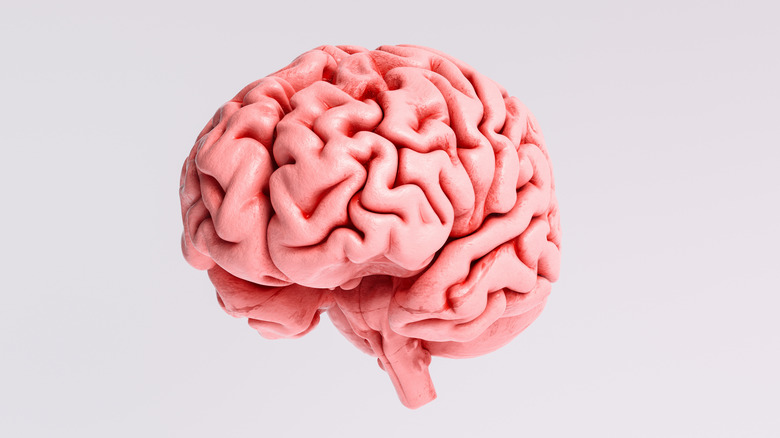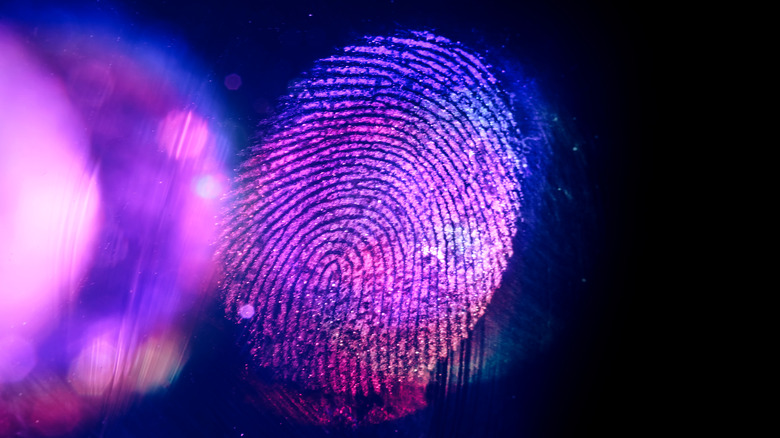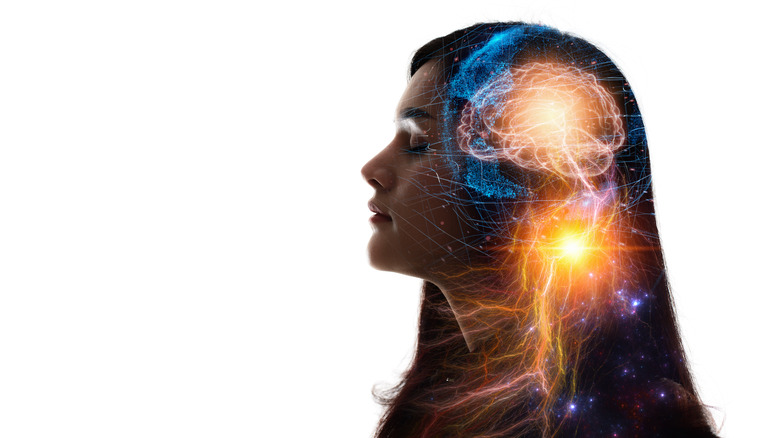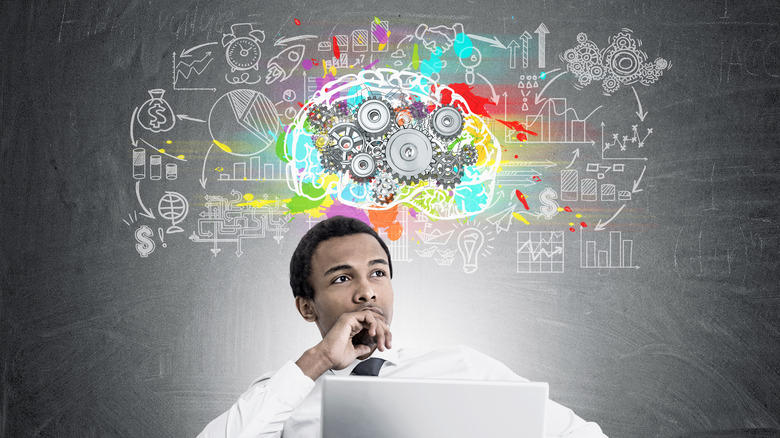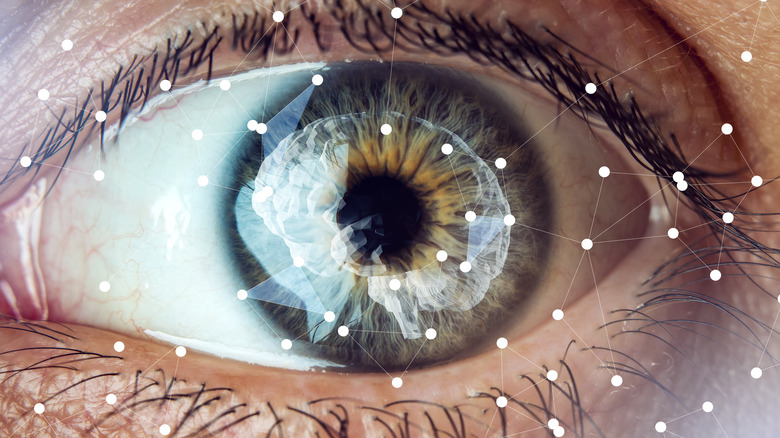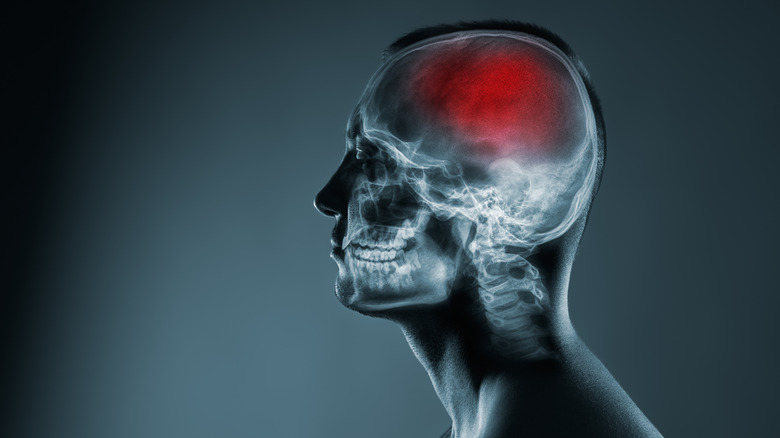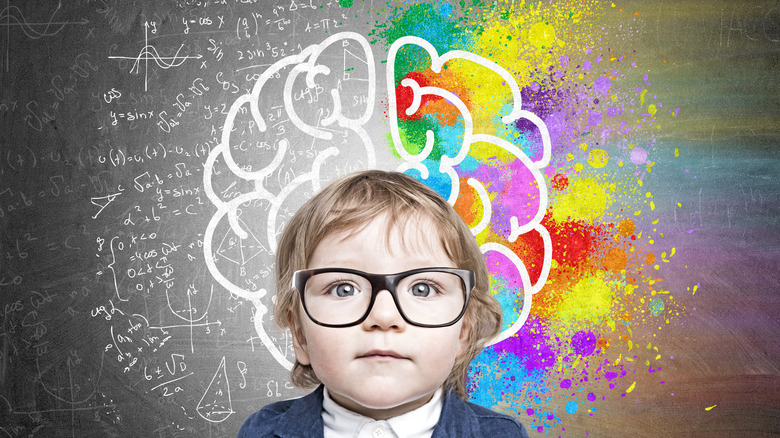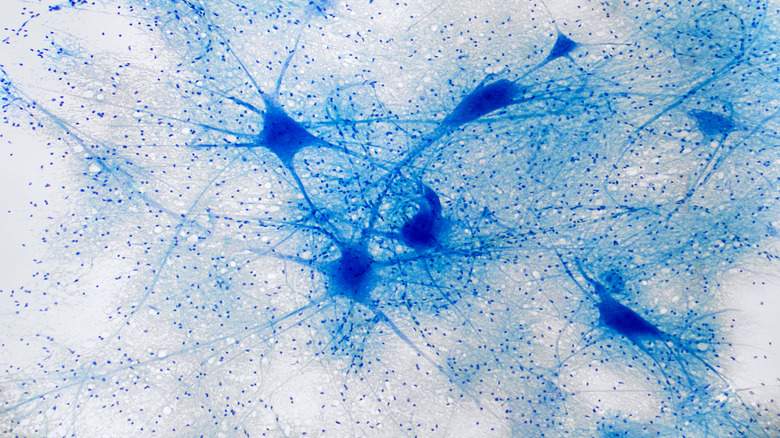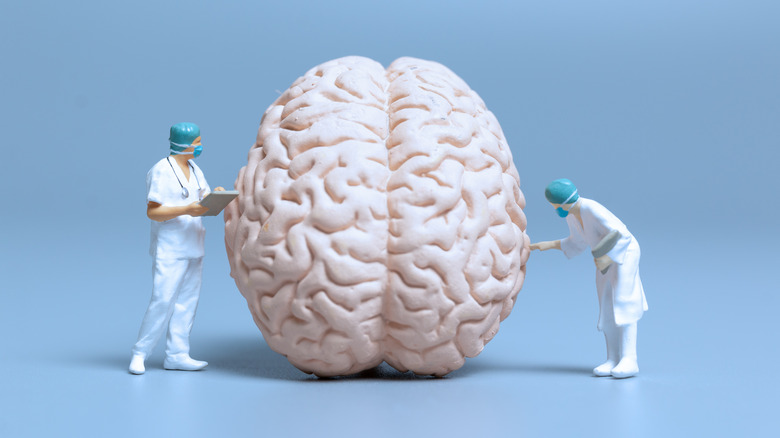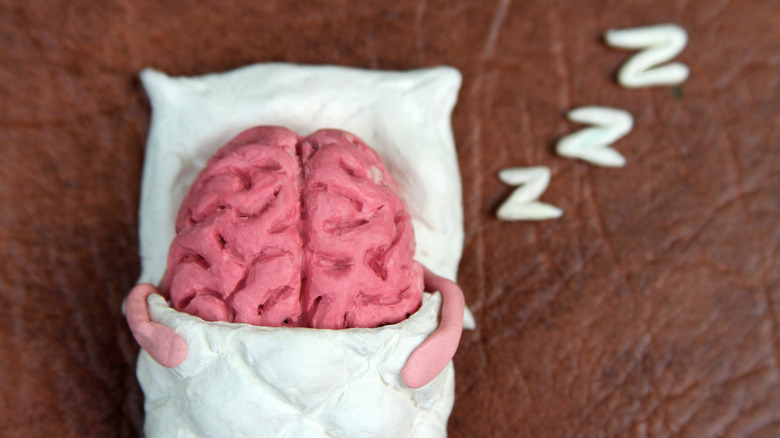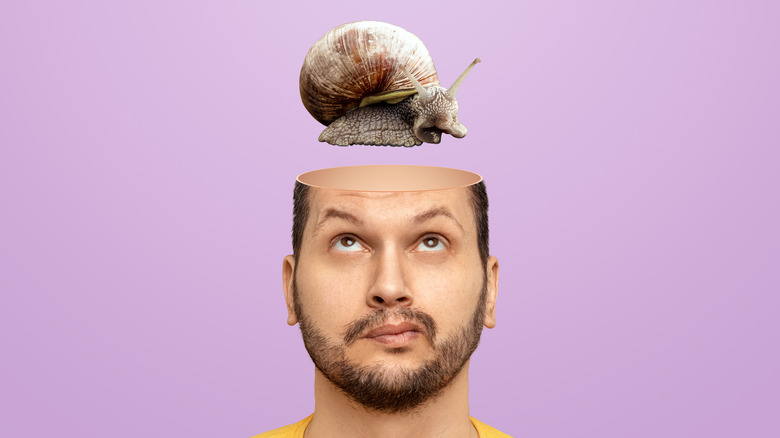Things You Never Knew About Your Brain
The human brain is like a faraway planet that's yet to be fully understood. Neuroscientists have sought to explore its complex terrain for decades, in an attempt to untangle many of the mind's mysteries. But existing research has just about scratched the surface of its outer rings.
In the past year alone, researchers identified special "math neurons" that fire exclusively during certain mathematical operations like additions and subtractions (via Current Biology). A 2021 study showed how the immune system acts as a watchdog of the brain, monitoring it for signs of infection or injury (via Cell). And for the first time, research revealed the internal anatomy of a mini-brain –- a pin-head-sized collection of different types of human brain cells -– offering a wider window into what's going on inside the brain (via Frontiers in Bioengineering and Biotechnology).
Even as scientists continue to unearth new discoveries, the human brain may just be one of the most complex and mind-boggling entities in the universe. Here are some things about your brain that may surprise you.
Your brain has its own unique fingerprint
We often perceive and talk about the human brain as a universal organ. Although our brains share many functional and structural similarities, they're also incredibly unique. Patterns of brain activity and neural connections differ from person to person, much like a fingerprint, reports a 2021 study published in the journal Science Advances. The researchers were able to correctly pair up MRI scans of the same individual's brain taken just a few days apart. In essence, they could identify an individual from their brain activity alone, namely their brain "fingerprint." And while it was easier to recognize a person when looking at brain activity occurring over several minutes, it was also possible to do so with a brain map captured over a shorter span of time.
Unlike an actual fingerprint, however, a brain "fingerprint" constantly changes over time (via Science Advances). For this reason, it may provide some early warning signs of neurodegenerative problems like Alzheimer's-related decline. The researchers discovered that patterns of brain activity start to disappear in patients with Alzheimer's disease, almost as though a person is losing their distinctive brain identity as the illness takes hold.
Our brains protect us from existential thoughts of death
Our brains are programmed to protect us in different ways (via Frontiers for Young Minds). They help us cope with the impact of trauma, the threat of danger, and even our imminent demise, according to a study published in NeuroImage. Fascinatingly, the brain's neurons work together to keep us from fixating on the idea that death will eventually befall us. The fear of death could potentially debilitate us. But the brain categorizes death as something that only happens to other people, making it difficult for us to truly comprehend the inevitability of our own mortality beyond an intellectual understanding.
By testing the way that individuals' brains responded to images coupled with words, the researchers found that the brain had a hard time associating itself with the idea of death (via NeuroImage). This particular mechanism kicks in early, when we first start to realize that people die, say the study authors. As children, our minds actively seek to avoid thoughts about death, which might be too overwhelming a concept to accept. Perhaps this evolved as a way for the brain to optimize its functioning and overall sense of wellbeing without being bogged down by the existential threat of death.
Brains have the consistency of Jell-O
When most people think about the brain, they probably think of a firm object –- like one of those plastic or rubber models we're used to seeing in museums. You may be surprised to learn, then, that your brain actually feels like a slab of Jell-O: Soft and mushy. Or perhaps a more accurate comparison is tofu, the soft variety, to be specific, says neurosurgeon Katrina Firlik in her book "Another Day in the Frontal Lobe: A Brain Surgeon Exposes Life on the Inside." As Firlik explains: "If you cut out a sizable cube of brain it retains its shape, more or less, although not quite as well as tofu." And when the brain is injured or swollen due to a tumor, stroke, infection, or blood clot, it becomes even softer.
The brain's squishy texture makes perfect sense. Our brain's are mostly made up of water and fat, and research shows it to be one of the fattiest organs in the body (via Acta Neurologica Taiwanica). When a brain is studied in a research lab, it may be chemically hardened using preservatives to keep it intact, so that it can be physically handled without getting damaged (via Journal of Pharmaceutical Sciences and Research).
The brain has an unlimited storage capacity
It may seem as though there's a physical limit to the amount of information we can store in our brains. Anyone who's spent hours studying is likely to have felt as though their brain just can't hold or take in any more information. But while our cognitive abilities may decrease as we tire, our brain's can't get full.
As it turns out, the brain has enough storage capacity to house an infinite library of books, based on the findings of a study from the journal eLife. The storage capacity of the human brain has long been underestimated, claim the researchers. Every time you learn or experience something new, your brain creates new connections between neurons, called synapses. These are like bridges that allow neurons to combine and carry information between one another. Each time you have the same experience, your brain strengthens and tunes these existing connections, which is how we form skills, habits, and knowledge.
The human brain has trillions of synapses. One synapse alone can store 4.7 bits of information, which far exceeds the memory and processing power of even the latest new computer, tablet, or smartphone.
The brain is a story-generating machine
Digging deeper into the innermost workings of the brain can offer up some clues as to why people love stories. In truth, life doesn't unfold in a linear fashion, but we find it easier to remember events that are tied together. This is because the hippocampus functions as the brain's storyteller, details a 2021 study from the journal Current Biology. It doesn't just remember distinct events from the past separately — it bridges these memories together to create a consistent and cohesive narrative.
Using brain-imaging technology, the researchers looked at participants' hippocampi as the individuals listened to and later recalled a series of short stories (via Current Biology). They observed greater activity in the hippocampus when people learned and remembered stories that had a connected storyline compared to the ones that were disjointed, which reflected deeper and richer recollection. The propensity of the hippocampus to weave memories into stories makes it easier for us to retell and share experiences, which may play an important role in human connection.
The eyes are extensions of the brain
The brain trawls through and digests leagues of information every second. The eyes, in particular, provide a very special channel: A window to both the external world and the brain itself.
The retina is a light-sensitive layer of tissue lining the back wall of the eye (via Cleveland Clinic). It's directly connected to the brain via the optic nerve, which carries visual information in the form of electrical impulses. The fact that the tissues, nerves, and vessels of the eyes are visible makes the eye a convenient tool for research. In a sense, the eyes are like extensions of the brain.
Physicians sometimes look out for changes in the eyes as a way to trace changes occurring in the brain, notes a 2021 study published in Frontiers in Psychology. Specifically, doctors can detect and diagnose neurological illnesses like dementia or a stroke by examining the optic nerve. People with Alzheimer's disease, and even those with a familial history of the illness, have been found to have altered blood vessels at the back of the eyes. Honing in on these changes and developing a more nuanced recognition of the visual symptoms of various conditions might help researchers and clinicians better diagnose and treat neurodegenerative diseases, claim the researchers. Physiological changes at the back of the eye can also signal diabetes, glaucoma, high blood pressure, and even a brain tumor.
There are no pain receptors in the brain
Fascinatingly, our brains are insensitive to pain. Which may leave you wondering: How do we suffer from headaches and migraines?
Although the brain doesn't have any pain receptors of its own, there are many other regions of the head that do, details the Wu Tsai Neurosciences Institute website. For instance, the blood vessels and muscles in your scalp, neck, and face are adorned with nociceptors, which are neurons that help protect the body by detecting damage or threat of damage and signaling the brain and spinal cord. The brain then tries to identify the location of the pain and what it means. In a sense, the body protects the brain just as the brain works to keep us safe.
Headache pain can arise in various different areas. And the brain is somewhat unskilled at pinpointing specifically where the sensation is coming from. For example, sinus pain can be easily mistaken and misdiagnosed as a migraine, while brain freeze is actually caused by the constriction of the blood vessels in the roof of the mouth.
The human brain doubles in size during the first year of life
Neurogenesis, namely the birth of new brain cells, is most active during the embryonic stage and in the first few years of life (via The Journal of Neuroscience). A baby's brain grows at lightning speed compared to adults, shows a study of the brains of healthy newborns from two days old (via JAMA Neurology). Specifically, an infant's brain grows by one percent each day, reaching 64% of its full size in the first three months. Its growth rate then slows down to 0.4 percent per day after that. Over the next 12 months, the brain continues to double in size, creating trillions of connections between cells (via Nature Reviews Neuroscience). It reaches about 80 percent of its adult size by age three. This is reflected in the explosive learning that takes place during this time.
The cerebellum, namely the area of the brain involved in movement and motor control, is the fastest-growing region after birth, based on the findings of the study (via JAMA Neurology). On the other hand, the hippocampus, which is responsible for the formation of autobiographical memory, grows the slowest, since remembering everyday events and personal experiences isn't integral to a baby's life. The brain's malleability means that our early years are critical for the developing brain. A child's early experiences can set the stage for good mental and cognitive health throughout life.
New brain cells are created all throughout life
Our early years are the most active time for stimulating the growth of new brain cells, a process known as neurogenesis (via The Journal of Neuroscience). It was once thought that neurogenesis rarely occurs in adult brains. But neurons and nerve cells are created all throughout life, even in older brains, according to a study published in the journal Nature Medicine.
The researchers examined the hippocampi of deceased people aged between 43 and 87. The hippocampus is a region that's crucial in regulating learning and establishing new memories, where neurogenesis is known to occur. It also happens to be the part of the brain that's most affected by Alzheimer's disease, an illness that robs people of their memories. The presence of doublecortin –- a protein found in neurons in the developing brain -– helped the researchers distinguish newly formed cells from old ones. They discovered thousands of these newly developed neurons in the brains of "neurologically healthy human subjects up to the ninth decade of life," whereas "the number and maturation of these neurons progressively declined" in people with Alzheimer's disease.
Our brains shrink as we get older
Your brain changes as you get older. Even though it retains its ability to create new cells and connections, brain development naturally declines with increasing age. This can be observed in the shrinkage of the brain, say researchers –- a process also known as brain atrophy (via Postgraduate Medical Journal).
From the age of 40, the human brain loses its volume at a rate of 5% per decade. And by the time you hit your 70s, the rate of shrinkage gets even greater. The reduction of grey matter volume may be the result of old brain cells dying, but more research is needed to investigate whether other contributing factors are at play here, too.
Brain shrinkage is particularly evident in the frontal cortex, which gets thinner over time, notes a 2021 study published in Frontiers in Mechanical Engineering. This is the brain's wrinkled outer layer, which is implicated in many complex executive functions like attention, planning, and problem-solving. Cortical thinning also affects the temporal lobes, which sit behind the ears. This region plays a key role in processing and understanding language and emotions as well as certain aspects of visual learning (via StatPearl). The hippocampus is the earliest structure of the brain to shrink in people with Alzheimer's disease and related neurological disorders (via Frontiers in Mechanical Engineering). Interestingly, the brain regions that are the first to degrade are the last to develop in life.
Your brain never sleeps
There's a longstanding myth that we only use ten percent of our brains. And while it's true that its billions of cells aren't firing at the same time, almost all of the brain's regions are being tapped into throughout the day (via Frontiers in Human Neuroscience). We even use more than ten percent when we're asleep.
Your brain never truly stops working. It may feel as though it's "switching off" when you fall into slumber, but this diligent little machine is very much still active. The brain cycles through two main stages during sleep: non-rapid eye movement (NREM) and rapid eye movement (REM) sleep (via Elife). Each has its own role in restoring your brain's cognitive abilities. Rapid eye movement (NREM) sleep is where your brain and body slow down. The final stages of NREM sleep, known as the deepest sleep stage, facilitate the consolidation of declarative memory, which is where general knowledge, personal experiences, and facts are stored over time (via Frontiers in Psychology). We usually dream during REM sleep and the brain exhibits similar patterns of activity as when we're awake, though, most of our muscles are paralyzed to prevent us from acting out our dreams (via Elife).
Despite being always-vigilant, the brain needs sleep to repair itself. Without sufficient shut-eye, your physical, emotional, and cognitive abilities would malfunction and the brain would start to glitch and shut down (via Nature Reviews Neuroscience). Lack of sleep can lead to serious neurological and psychiatric problems.
Dreams help the brain discard useless memories
There are myriad theories on how dreams cater to the brain. It's long been believed that dreams help us think more clearly. They do this by "cleaning out" the clutter from our minds, categorizing what's important and what isn't, explains a study published in the journal Science. Special neurons actively fire during the rapid eye movement (REM) stage of sleep to help us forget useless memories. These cells are identified as melanin-concentrating hormone-producing (MCH) neurons, which are located in the hypothalamus — a region of the brain that takes care of various important functions including appetite and sleep. The MCH neurons have been found to interfere with memory consolidation, which might account for why most of us have difficulty recalling our dreams. From this perspective, dreams may have evolved as a way to help protect the mind from becoming overloaded by getting rid of unimportant information.
Our dreams may seem bizarre but their random and disjointed nature might actually serve a purpose, suggest some researchers (via Patterns). Rather than mirroring the day's events and replaying them as they occurred, dreams are typically a surreal mash-up of various experiences, thoughts, and memories. Their hallucinatory quality helps to erase detail, which allows the brain to retain the generalizability of its perceptual and cognitive abilities, preventing them from becoming inflexible. Indeed, it's clear that there's still a lot we don't know about the brain's complex architecture, contents, and mechanisms.

